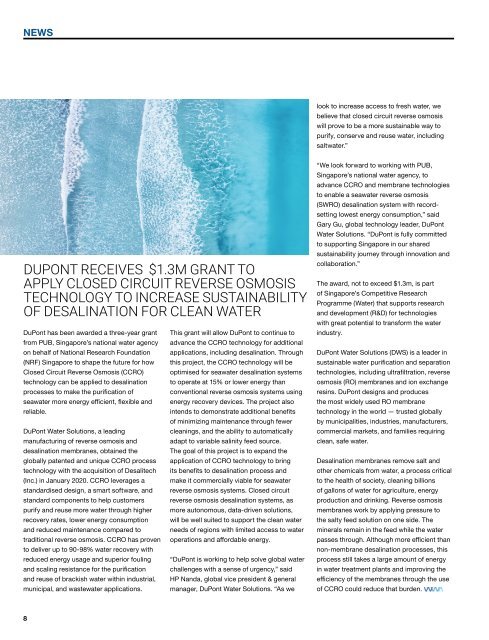Water & Wastewater Asia March/April 2021
Water & Wastewater Asia is an expert source of industry information, cementing its position as an indispensable tool for trade professionals in the water and wastewater industry. As the most reliable publication in the region, industry experts turn this premium journal for credible journalism and exclusive insight provided by fellow industry professionals. Water & Wastewater Asia incorporates the official newsletter of the Singapore Water Association (SWA).
Water & Wastewater Asia is an expert source of industry information, cementing its position as an indispensable tool for trade professionals in the water and wastewater industry. As the most reliable publication in the region, industry experts turn this premium journal for credible journalism and exclusive insight provided by fellow industry professionals. Water & Wastewater Asia incorporates the official newsletter of the Singapore Water Association (SWA).
You also want an ePaper? Increase the reach of your titles
YUMPU automatically turns print PDFs into web optimized ePapers that Google loves.
NEWS<br />
look to increase access to fresh water, we<br />
believe that closed circuit reverse osmosis<br />
will prove to be a more sustainable way to<br />
purify, conserve and reuse water, including<br />
saltwater.”<br />
DUPONT RECEIVES $1.3M GRANT TO<br />
APPLY CLOSED CIRCUIT REVERSE OSMOSIS<br />
TECHNOLOGY TO INCREASE SUSTAINABILITY<br />
OF DESALINATION FOR CLEAN WATER<br />
DuPont has been awarded a three-year grant<br />
from PUB, Singapore’s national water agency<br />
on behalf of National Research Foundation<br />
(NRF) Singapore to shape the future for how<br />
Closed Circuit Reverse Osmosis (CCRO)<br />
technology can be applied to desalination<br />
processes to make the purification of<br />
seawater more energy efficient, flexible and<br />
reliable.<br />
DuPont <strong>Water</strong> Solutions, a leading<br />
manufacturing of reverse osmosis and<br />
desalination membranes, obtained the<br />
globally patented and unique CCRO process<br />
technology with the acquisition of Desalitech<br />
(Inc.) in January 2020. CCRO leverages a<br />
standardised design, a smart software, and<br />
standard components to help customers<br />
purify and reuse more water through higher<br />
recovery rates, lower energy consumption<br />
and reduced maintenance compared to<br />
traditional reverse osmosis. CCRO has proven<br />
to deliver up to 90-98% water recovery with<br />
reduced energy usage and superior fouling<br />
and scaling resistance for the purification<br />
and reuse of brackish water within industrial,<br />
municipal, and wastewater applications.<br />
This grant will allow DuPont to continue to<br />
advance the CCRO technology for additional<br />
applications, including desalination. Through<br />
this project, the CCRO technology will be<br />
optimised for seawater desalination systems<br />
to operate at 15% or lower energy than<br />
conventional reverse osmosis systems using<br />
energy recovery devices. The project also<br />
intends to demonstrate additional benefits<br />
of minimizing maintenance through fewer<br />
cleanings, and the ability to automatically<br />
adapt to variable salinity feed source.<br />
The goal of this project is to expand the<br />
application of CCRO technology to bring<br />
its benefits to desalination process and<br />
make it commercially viable for seawater<br />
reverse osmosis systems. Closed circuit<br />
reverse osmosis desalination systems, as<br />
more autonomous, data-driven solutions,<br />
will be well suited to support the clean water<br />
needs of regions with limited access to water<br />
operations and affordable energy.<br />
“DuPont is working to help solve global water<br />
challenges with a sense of urgency,” said<br />
HP Nanda, global vice president & general<br />
manager, DuPont <strong>Water</strong> Solutions. “As we<br />
“We look forward to working with PUB,<br />
Singapore’s national water agency, to<br />
advance CCRO and membrane technologies<br />
to enable a seawater reverse osmosis<br />
(SWRO) desalination system with recordsetting<br />
lowest energy consumption,” said<br />
Gary Gu, global technology leader, DuPont<br />
<strong>Water</strong> Solutions. “DuPont is fully committed<br />
to supporting Singapore in our shared<br />
sustainability journey through innovation and<br />
collaboration.”<br />
The award, not to exceed $1.3m, is part<br />
of Singapore’s Competitive Research<br />
Programme (<strong>Water</strong>) that supports research<br />
and development (R&D) for technologies<br />
with great potential to transform the water<br />
industry.<br />
DuPont <strong>Water</strong> Solutions (DWS) is a leader in<br />
sustainable water purification and separation<br />
technologies, including ultrafiltration, reverse<br />
osmosis (RO) membranes and ion exchange<br />
resins. DuPont designs and produces<br />
the most widely used RO membrane<br />
technology in the world — trusted globally<br />
by municipalities, industries, manufacturers,<br />
commercial markets, and families requiring<br />
clean, safe water.<br />
Desalination membranes remove salt and<br />
other chemicals from water, a process critical<br />
to the health of society, cleaning billions<br />
of gallons of water for agriculture, energy<br />
production and drinking. Reverse osmosis<br />
membranes work by applying pressure to<br />
the salty feed solution on one side. The<br />
minerals remain in the feed while the water<br />
passes through. Although more efficient than<br />
non-membrane desalination processes, this<br />
process still takes a large amount of energy<br />
in water treatment plants and improving the<br />
efficiency of the membranes through the use<br />
of CCRO could reduce that burden.<br />
8


















